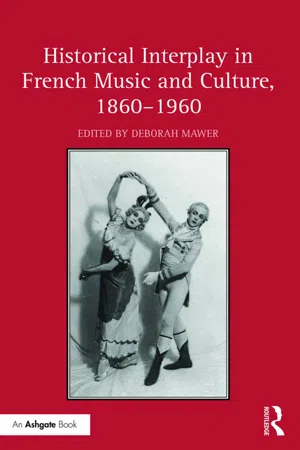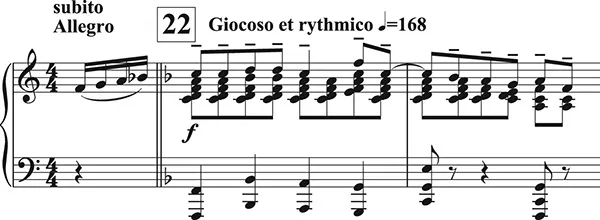![]()
Part I
French music and culture, 1860–1930
![]()
1 Patrimoine in French music
Layers and crosscurrents from the Romantics to the 1920s
Katharine Ellis
The French have long been good at historical interplay. If the architectural chaos of London appears endearingly accidental, there is something much more poised about the planned demolitions of Haussmannization in Paris, the historical resonances of the buildings that arose from it, and the buildings that have, in subsequent decades, engaged stylistically with it. For musicologists wedded to the nineteenth century, the Palais Garnier epitomizes such concerns: a project of the Haussmann era that managed to sum up its own time while referencing several others as well. Starker, but also more playful, is a late 1980s example which many will remember starting off as a worryingly big hole in the main quadrangle of the Louvre.
With its pyramids of glass surrounded by stone-built French classicism, the Louvre project of 1989 was a bicentennial gesture of monumental proportions. It was also a case study in how to juxtapose historical and aesthetic contrasts without creating mere rupture, of how to re-present the past through the lens of the present, and of how different pasts might coexist to afford the experience of a new rhythmic interplay. From the level of the quadrangle itself one tends to see two architectural phenomena of stone and glass in dialogue; by contrast, looking up from the escalators inside the main pyramid, one sees better through the tinted glass, to the stone facades all around; and the new reframes the old via its outsize evocation of leaded windows. On a grander scale, the Parisian flâneur heading westwards can enjoy the conversation between ancient Egypt, Napoleonic triumphalism and Mitterand’s grands projets. The glass pyramids, large and small, of the Chinese-American architect I.M. Pei, complement the ancient Luxor obelisk, one of a pair given by Egypt to France and erected at the Place de la Concorde in 1836; in between lies the smaller Arc de Triomphe du Carrousel, while the monumental one at the head of the Champs-Élysées is paired with the Grande Arche de la Défense, completed, like Pei’s pyramids, in 1989.
The Louvre’s new addition to the marriage of the Egyptian and the Napoleonic along Paris’s axe historique extends the principle of historical layering already present by association. The obelisk has no direct connection with the Napoleonic era, still less with Napoleon’s famous Egyptian campaign; but to today’s onlooker the intercalation of triumphal Napoleonic arches and monumental Egyptian silhouettes suggests a different story of imperial(ist) pasts and presents. History becomes a matter of perception, and of the filling in of evidential lacunae based on experience, imagination, intuition and, inevitably, assumption. As such it is interactive, encouraging mental games. These instances of architectural eclecticism, of dialogue and of neoclassical layering are erected as contributions to patrimoine and become its exemplars.
We can say the same of French music across several centuries, together with much music that has become indelibly associated with France or, more usually, with its capital city. Music, though, adds more complexity to the picture of city planning that I have just drawn because of its capacity to span everything from the monumental to the intimate. Notably, where patrimoine is concerned, it has the capacity to evoke loss or yearning – resulting in a musical analogue of mal du pays – of homesickness or nostalgia where historical time, place and rootedness fuse anywhere between agony or a wistful melancholy of separation. At the opposite extreme, music can deliver quicksilver intertextualities that even the multiple historical references of an eclectic building such as the Palais Garnier cannot match. Allusive music becomes play in more than just the compositional sense: as a listener, to engage in a game of musical ‘snap’ with an unfamiliar piece of Francis Poulenc is to court failure every few seconds, but probably to be delighted in the attempt. But which pasts count in this French world of historical reference? Whose heritage is brought into play, and whose does it become? And what, from composer to national community, are the benefits and risks?
Anachronisms
In a study of nineteenth-century interplay which admits less of the ‘historical’ of the current project’s title, Christopher Reynolds addresses the double bind of (mostly German) Romantic composers wanting to preserve their status as original artists while creating intertextual webs of allusion in a spirit of homage and among friends. Allusive play becomes reputationally dangerous, frequently requiring concealment from public view; but equally it is a means of bonding initiates together in mutual recognition of complex musical debts.1 However, if Romantic exigencies weaken, and/or interplay becomes a more public tool for community-building, the tables turn and the risks of allusion or more general anachronism can become strengths. It is with such circumstances in France that this chapter is concerned: those increasingly characteristic of a period when anachronistic allusion took on public, rather than private, importance, as a statement about patrimoine.
To think about these questions I should like to start obliquely, and towards the end of the period, by borrowing from music theorist Martha Hyde’s work on neoclassicism and anachronism in Ravel, Stravinsky, Bartók and Schoenberg.2 Wanting to replace the idea of neoclassicism as a polemical, pejorative or permissive historiographical category, Hyde looked for patterns of use and motivation in composers’ creative relationships with the past – patterns that might yield a typology. Key to her argument was a non-pejorative interpretation of the idea of anachronism. In a later formulation (2003) of ideas first published in 1996, she wrote:
When anachronism – that is, the conflict between period elements in a piece of music – is meaningful, then a phoenix springs from the ashes. When it is not, then only a corpse emerges, shrunken and mummified from the tomb, though perhaps ornamented with modern trinkets. The main question is not whether anachronism has been avoided, but whether it has been controlled. If not, then no itinerary between past and present is opened, no genuine renewal occurs, and the impulse to revive the past is abortive or trivial.3
From the point of view of French music, that reference to the ‘trivial’ is important. Hyde’s fidelity to a strand of seriousness in music causes her to outlaw the parodic and the playful; indeed her 1996 opening weaves into the very rationale of the essay the necessity to progress beyond the superficial or trivial. The definition of the neoclassical, she writes, has been problematic in music because ‘music [and presumably musicology] has been unable to distinguish between genuine neoclassical works and those that wear a ruffle here or perform a dance step there as witty gestures or momentary satires in an allusive pantomime’.4 The terms of her rescue of neoclassicism hint at a centuries-long tradition whereby disparaged musics are feminized via reference to fashion accessories, and it is probably significant that Hyde’s sole French-music analysis is avowedly serious – Ravel’s Le Tombeau de Couperin; but she also echoes commentaries of the 1920s in Paris from critics wrong-footed by recent developments in anti-Romanticism and anti-Impressionism – critics such as Émile Vuillermoz, who when faced with Mavra and Renard decided that Stravinsky had ‘lapsed into humour’.5 My task here is more open-ended than Hyde’s definitional quest; and because to ignore ‘trivial’ interplay in French music would also be to ignore some of its radicalism, I should like to rehabilitate the parodic and the humorous as potentially anachronistic categories within the discussion that follows, while still taking cues from Hyde’s work.
Hyde lists four overlapping categories of ‘imitation’ in which anachronism takes different forms: reverential (where entire musical texts are borrowed and recast as a form of homage); eclectic (where echoes and allusions are compiled from several sources and chronological periods, seemingly at random); heuristic (where dependence on a past model, whether of art or folk music, is part of the music’s rationale to integrate tradition with the new) and dialectical (not a specifically Hegelian concept, but one where content alluding to past and present are channelled into a drama of oppositions).6 Schoenberg’s Third String Quartet and Stravinsky’s The Rake’s Progress serve as Hyde’s dialectical models in 1996 and 2003 respectively, while Bartók’s Improvisations, Op. 20 and the Symphony in C are heuristic; the Stravinsky Octet serves as the eclectic point of reference in both essays. Finally, Hyde’s first model of ‘reverential imitation’ is Ravel’s ‘Forlane’ from Le Tombeau, while in her Stravinsky essay the same role is taken by Le Baiser de la fée and (more problematically for Hyde because of its proximity to mere ‘arrangement’) by Pulcinella – this latter being a work which in its French reception of the 1920s immediately illustrates how porous are Hyde’s four categories in French compositional hands, specifically those of Poulenc.
In Monte Carlo and Paris alike, the ballet Les Biches (premiered 1924) revealed a young Poulenc out-Stravinskying Stravinsky in (mock-)reverential and eclectic fashion together. This jeu d’esprit, which seems to wear triviality almost as a badge of honour, worked against the Stravinskian grain by alluding not only to eclectic works (such as the Octet), but also to Stravinsky’s reverential music (Pulcinella), his heuristic evocations of the Russian folk in Les Noces and Le Sacre du printemps, and, in the ‘Rag-Mazurka’, his jazzed-up cimbalom for the Ragtime for Eleven Instruments. As the ‘Giocoso et rythmico’ of the ballet’s Rondeau illustrates, Poulenc’s references are multi-layered (see Example 1.1).
His first-order allusion is to the finale of Pulcinella (Allegro), this latter itself based on the Presto of the Trio Sonata No. 12 in E, by Domenico Gallo – which results in a second-order allusion. Other Stravinskian parodies include precocious reference to the Russian’s growing debt to Tchaikovsky at the expense of ‘The Five’, and in turn to Tchaikovsky’s love of Mozart.7 An appoggiatura-laden string interpolation at score rehearsal Fig. 32 nods towards the finale of the ‘Pathétique’ Symphony, even crossing inner parts (and adding a ‘cross’ symbol in the piano score) ...

